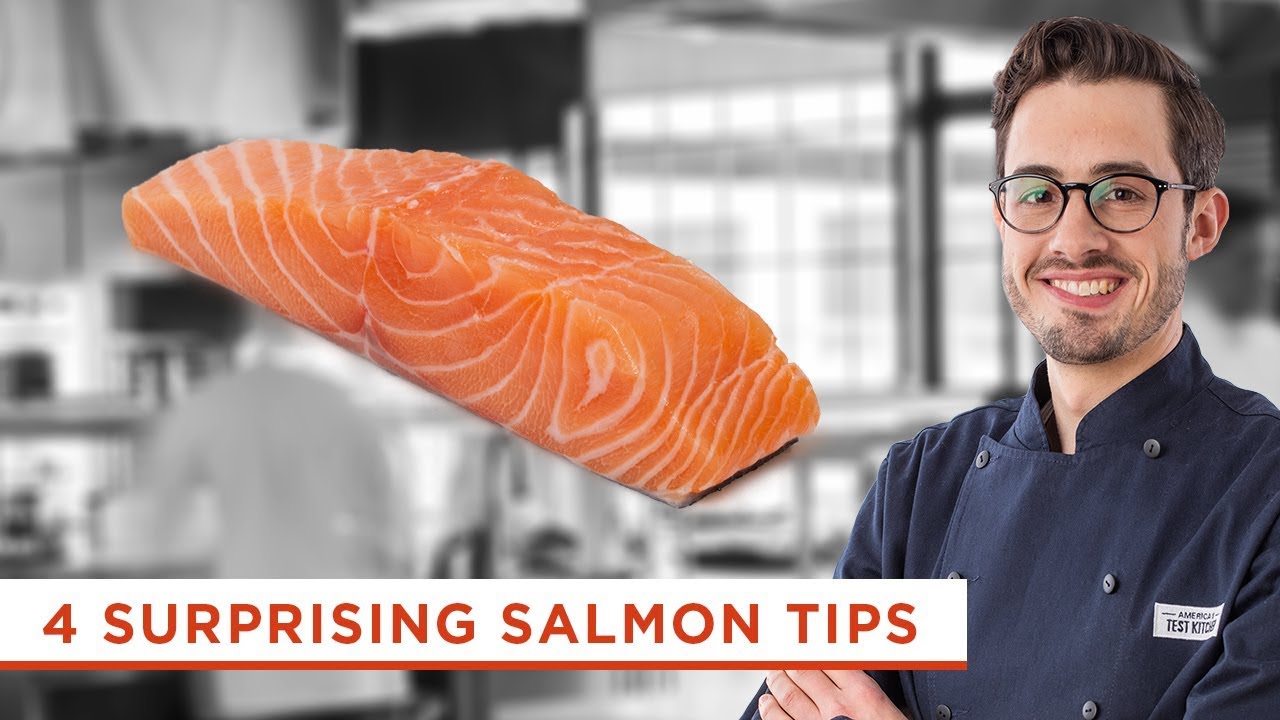Click here to watch more kitchen tips:
If you love to cook salmon, you have to know these four tips.
We review Santoku knives and find the best one:
Here’s how to perfectly brown fish:
STORING
As soon as you get home from the store, put your salmon on ice. Salmon can last twice as long when stored closer to 32 degrees rather than the normal 40 degrees of your fridge. Put the fish in a zipper lock bag and place it into a bowl of ice at the back of the fridge.
REMOVING PIN BONES
When a fish is filleted, the flesh is removed from the backbone and ribs, but the relatively soft, thin, needle-like pinbones, also known as intermuscular bones, are not attached to the main skeleton and thus must be removed in a second step. While most fish are sold with the pinbones removed, they are difficult to see and are sometimes missed by the fishmonger.
1. Drape fillet over inverted mixing bowl to help any pinbones protrude. Then, working from head end to tail end, locate pinbones by running your fingers along length of fillet.
2. Use tweezers to grasp tip of bone. To avoid tearing flesh, pull slowly but firmly at slight angle in direction bone is naturally pointing rather than straight up. Repeat until all pinbones are removed.
HOW TO COOK EVENLY
The salmon fillets we get from our fishmonger often have the belly portion still attached. With oven roasting or pan searing, this thinner section will inevitably overcook by the time the thicker meaty portion of the salmon fillet is done. Instead of wastefully cutting it off, fold over the flap and secure it in place with a toothpick. This will ensure that it cooks on pace with the rest of the fillet.
BRINING SALMON
In the test kitchen, we brine meats like turkey, chicken, pork, and lamb to improve both flavor and texture. But brining fish can be beneficial, too. We set up a series of tests using different brine concentrations (3, 6, and 9 percent salt-to-water solutions by weight) and types of fish (tuna, salmon, swordfish, and halibut). We found that, for up to six 1-inch-thick steaks or fillets, the optimum concentration was a 6 percent brine (5 tablespoons of salt dissolved in 2 quarts of water) and the ideal time was 15 minutes. It worked no matter the species, improving the texture of the fish without overseasoning.
As it does with meat, brining fish serves two purposes: One, it helps season the flesh, which improves flavor, and two, by partially dissolving muscle fibers to form a water-retaining gel, it helps prevent the protein from drying out. And brining works a lot faster on fish because the structure of muscle in fish is different than that in meat: Instead of long, thin fibers (as long as 10 centimeters in meat), fish is constructed of very short (up to 10 times shorter) bundles of fibers.
In addition, we seared each species of fish to see if using a wet brine would inhibit browning. Luckily, it did not, so long as the fish was dried well with paper towels just before cooking. Finally, we’ve found that brining helps reduce the presence of albumin, a protein that can congeal into an unappealing white mass on the surface of the fish when heated.
ABOUT US: Located in Boston’s Seaport District in the historic Innovation and Design Building, America’s Test Kitchen features 15,000 square feet of kitchen space including multiple photography and video studios. It is the home of Cook’s Illustrated magazine and Cook’s Country magazine and is the workday destination for more than 60 test cooks, editors, and cookware specialists. Our mission is to test recipes over and over again until we understand how and why they work and until we arrive at the best version.
If you like us, follow us:
Related posts
25 Comments
Leave a Reply Cancel reply
You must be logged in to post a comment.


If I meal prep teriyaki salmon, how long will it last In a meal prep container in my fridge ?
Can i freez salmon and keep in the fridge
I love this Video. Not stretching with useless information. Pap Pap Pap over. Love it
His lower lip is a bit …strange?
great video.
Did he have a stroke?
Thank you for the tips
This guys crooked mouth is very distracting .
This guy is a power bottom
Forget basic tip, cover in salt and sugar for 15 minutes to firm fish up…- grant chef steps
What a fraud
Wow- you guys are harsh! Tried this tonight and it came out nicely. 1T salt in 2c water for 30 min.
"32 degrees" … oh, right, "america's" test kitchen. >_>
That was weird.
He lost me when he mispronounced albumin as al-BEW-men
1. Do not eat farmed salmon(check origins)
2. Always check the meat for worms (very common)
3. Check how old it is
4. Skip 1.2.3 and just go vegan!
The bottom of the refrigerator is the coldest, not the back.
Show the salmon…dang.
Removing bones only works when the filet is old ( around one week ) or immediately after the fish has been slaughtered.
Oh, use "clean tweezers"…. so I need to wash them…. that was the problem…
I hate it when they pronounce samom…salmon
Broiling turns fragile salmon oil rancid, that is why your house smells.
Do you guys have or could make a video about brining like you say in your notes? For different kinds of meats and fish.
#5 Just say no to farm raised salmon, in particular Atlantic Salmon.
Hey there. I always enjoy watching the action going on behind you. I often film my self using a green screen shoing something interesting behind me. Keep the great tips coming!
God forbid you show some actual salmon and demonstrate what you're saying.